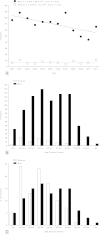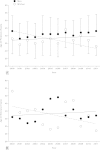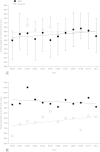Sex and age-related differences in performance in a 24-hour ultra-cycling draft-legal event - a cross-sectional data analysis
- PMID: 24883191
- PMCID: PMC4039327
- DOI: 10.1186/2052-1847-6-19
Sex and age-related differences in performance in a 24-hour ultra-cycling draft-legal event - a cross-sectional data analysis
Abstract
Background: The purpose of this study was to examine the sex and age-related differences in performance in a draft-legal ultra-cycling event.
Methods: Age-related changes in performance across years were investigated in the 24-hour draft-legal cycling event held in Schötz, Switzerland, between 2000 and 2011 using multi-level regression analyses including age, repeated participation and environmental temperatures as co-variables.
Results: For all finishers, the age of peak cycling performance decreased significantly (β = -0.273, p = 0.036) from 38 ± 10 to 35 ± 6 years in females but remained unchanged (β = -0.035, p = 0.906) at 41.0 ± 10.3 years in males. For the annual fastest females and males, the age of peak cycling performance remained unchanged at 37.3 ± 8.5 and 38.3 ± 5.4 years, respectively. For all female and male finishers, males improved significantly (β = 7.010, p = 0.006) the cycling distance from 497.8 ± 219.6 km to 546.7 ± 205.0 km whereas females (β = -0.085, p = 0.987) showed an unchanged performance of 593.7 ± 132.3 km. The mean cycling distance achieved by the male winners of 960.5 ± 51.9 km was significantly (p < 0.001) greater than the distance covered by the female winners with 769.7 ± 65.7 km but was not different between the sexes (p > 0.05). The sex difference in performance for the annual winners of 19.7 ± 7.8% remained unchanged across years (p > 0.05). The achieved cycling distance decreased in a curvilinear manner with advancing age. There was a significant age effect (F = 28.4, p < 0.0001) for cycling performance where the fastest cyclists were in age group 35-39 years.
Conclusion: In this 24-h cycling draft-legal event, performance in females remained unchanged while their age of peak cycling performance decreased and performance in males improved while their age of peak cycling performance remained unchanged. The annual fastest females and males were 37.3 ± 8.5 and 38.3 ± 5.4 years old, respectively. The sex difference for the fastest finishers was ~20%. It seems that women were not able to profit from drafting to improve their ultra-cycling performance.
Keywords: Cycling; Master athletes; Sex difference; Ultra-endurance.
Figures





Similar articles
-
Sex Difference in Draft-Legal Ultra-Distance Events - A Comparison between Ultra-Swimming and Ultra-Cycling.Chin J Physiol. 2016 Apr 30;59(2):87-99. doi: 10.4077/CJP.2016.BAE373. Chin J Physiol. 2016. PMID: 27080464
-
Age and gender difference in non-drafting ultra-endurance cycling performance - the 'Swiss Cycling Marathon'.Extrem Physiol Med. 2013 Jun 4;2(1):18. doi: 10.1186/2046-7648-2-18. Extrem Physiol Med. 2013. PMID: 23849106 Free PMC article.
-
Sex differences in 24-hour ultra-marathon performance--a retrospective data analysis from 1977 to 2012.Clinics (Sao Paulo). 2014 Jan;69(1):38-46. doi: 10.6061/clinics/2014(01)06. Clinics (Sao Paulo). 2014. PMID: 24473558 Free PMC article.
-
Trends in Triathlon Performance: Effects of Sex and Age.Sports Med. 2013 Sep;43(9):851-63. doi: 10.1007/s40279-013-0067-4. Sports Med. 2013. PMID: 23797729 Review.
-
Master Athletes Are Extending the Limits of Human Endurance.Front Physiol. 2016 Dec 12;7:613. doi: 10.3389/fphys.2016.00613. eCollection 2016. Front Physiol. 2016. PMID: 28018241 Free PMC article. Review.
Cited by
-
Master athletes and "1001 miles", the longest and most extreme European randonnée.J Prev Med Hyg. 2019 Dec 20;60(4):E428-E430. doi: 10.15167/2421-4248/jpmh2019.60.4.1370. eCollection 2019 Dec. J Prev Med Hyg. 2019. PMID: 31967102 Free PMC article. No abstract available.
-
Can the Performance Gap between Women and Men be Reduced in Ultra-Cycling?Int J Environ Res Public Health. 2020 Apr 7;17(7):2521. doi: 10.3390/ijerph17072521. Int J Environ Res Public Health. 2020. PMID: 32272640 Free PMC article.
-
Ultra-Cycling- Past, Present, Future: A Narrative Review.Sports Med Open. 2024 Apr 29;10(1):48. doi: 10.1186/s40798-024-00715-7. Sports Med Open. 2024. PMID: 38679655 Free PMC article. Review.
-
Participation and Performance Trends in the Oldest 100-km Ultramarathon in the World.Int J Environ Res Public Health. 2020 Mar 6;17(5):1719. doi: 10.3390/ijerph17051719. Int J Environ Res Public Health. 2020. PMID: 32155703 Free PMC article.
References
-
- Cejka N, Rüst CA, Lepers R, Onywera V, Rosemann T, Knechtle B. Participation and performance trends in 100-km ultra-marathons worldwide. J Sports Sci. 2013. Epub ahead of print. - PubMed
LinkOut - more resources
Full Text Sources
Other Literature Sources

